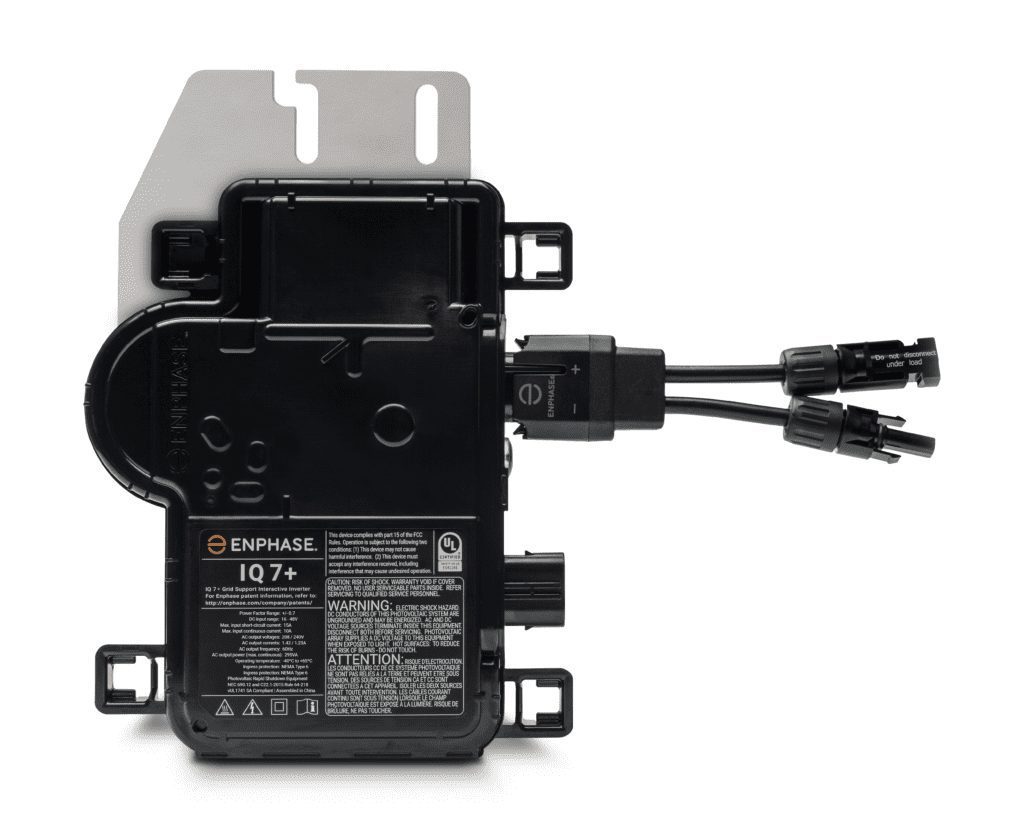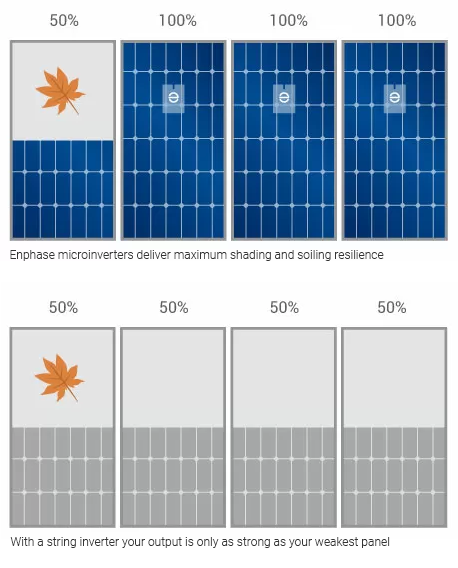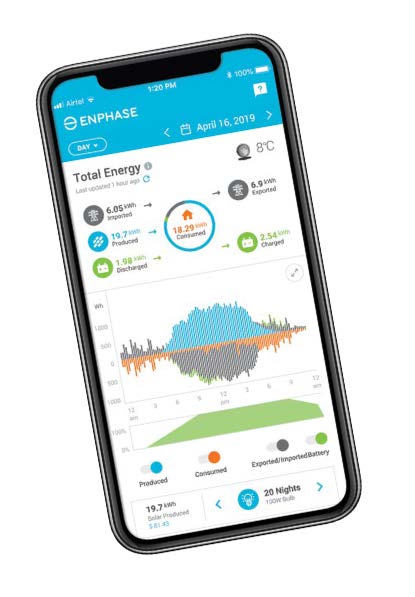
It’s a good question. If you already have solar panels you probably know that a solar inverter is a necessary part of the system. The inverter converts the power the panels produce, direct current (DC), to alternating current (AC). It is only AC current that can be safely used in the household or exported back to the grid. If any friends or family have a rooftop solar array, you would’ve seen the solar inverter in the garage or affixed to a wall.
Anyone bar an electrical engineer may know exactly what a microinverter is. While a standard solar inverter converts the DC to AC from an entire solar array, a microinverter does the job on each individual solar panel. To do this job, microinverters are attached to the rear side of each solar panel.
While standard household solar inverters, known as string inverters, connect with multiple solar modules, the benefit of a microinverter is that each panel becomes electrically isolated from every other panel. This means that any faults, reduced power output as a result of shadows, dust, bird droppings or damage that may impact an individual panel, do not impact on the power output of its neighbouring panels.
Basically, a solar array using conventional inverters behave more like society at large, moving as fast as the slowest panel. But microinverters celebrate individualism, and in the case of a solar array this means each panel is operating at the optimum, unhindered by its fellows.
It may come as a surprise to learn that your solar panels might be generating different amounts of energy even if they are grouped together on one roof section. Solar panels in a single system are connected together into a string – essentially one or more rows of solar panels. And the amount of power that comes out of the panels is only equal to the worst-producing panel.
Actually, it is quite common for rooftop panels to vary in power output as a result of factors as simple as a nearby tree shading one or more of the panels in the string. Dust or other “soiling”, like bird droppings, can also accumulate on one panel in the string, reducing the power output of them all.
It is also possible that the power output of each of your solar panels was not equally matching when they left the factory floor. They may even “degrade”, or reduce in power output, differently over time. But most typically, power output differences between panels can be put down to facing different directions or being impacted by shading.

For homeowners there are all sorts of obstacles that can introduce shading to a solar array, perhaps it’s an overhanging tree, a chimney, a neighbour’s chimney, a satellite dish, it could be any number of things. But can microinverters reduce the impact of this shading on the generation profile of your solar array? The short answer is yes.
With a string or centralised inverter system the impact of shading on one panel can leech to every other panel in the system. But microinverters perform MPPT tracking on each module to ensure the impact of shading on a single module is isolated to module alone. Of course, this does not mean the output of the shaded or partially shaded panel will improve, but it does mean the rest of the panels won’t be dragged down with it.
Another added benefit of microinverters is that they convert the DC power emanating from a solar panel into AC power at the point of generation, which is to say, at the panel. This means that unlike string inverters, microinverters does away with the need to have DC cables running through your roof and home. If you are installing a larger solar system to your home, which is the current trend as more devices within the home become electrified, the amount of cabling required in total is reduced through the use of microinverters.
Additionally, microinverters do not require the installation of a rooftop DC isolator – which was long a requirement in Australia, and a cause of more problems than they solved. In November 2021, Australia removed its much criticised DC isolator mandate after they were blamed for an increasing number of fires in solar systems.

Since microinverters monitor the production of every panel individually, not only is a system less susceptible to production losses compared to a system using a string inverter, but potential issues with your array are also easier to identify. If, for instance, one of your panels is underperforming, the Enphase MyEnlighten monitoring app will be able to tell you which panel is at fault. Perhaps the panel has been soiled by dirt or bird droppings and simply needs to be cleaned.
Without a microinverter you wouldn’t be able to narrow down a issue in your system’s production, and might have to pay someone to inspect your system for you.
It has been gauged that for all the added benefits they provide, microinverters can cost 20-30% more than their conventional cousins the string inverter. Judging by prices in the US market, when the Enphase IQ8 microinverters do land on Australian shores sometime before the end of 2022, a price point somewhere in the ballpark of $250 a pop could be expected.


















All of the advantages above provide very good reasons to make the extra investment upfront for the additional safety, performance, and peace-of-mind that microinverters deliver. And the overarching principle informing microinverters provides a further incentive.
Increasingly, the solar inverter is being understood as the brains of a rooftop PV system. It’s where the power, watts, can be understood as bytes – data. Each microinverter collects data about your system and can allow you to access that data via an app.
As a Silicon-Valley based technology company, the Enphase team has demonstrated that it understands the value of data – right down to the individual solar panel. By maximising power output, providing that data to you as the system owner, and integrating seamlessly with its in-house battery system, a rooftop solar system plugged into Enphase microinverters appears to be an increasingly clever choice.
The first thing to say about the IQ Battery is that it’s not just a battery, it’s also the IQ 8X-BAT microinverters in the IQ Battery unit. So not only does the IQ Battery store your excess solar energy for later use or for during a power outage, but the microinverters ensure the entire system from solar panel to storage and the electrical circuits in your home are working together and optimally.
The IQ Battery comes in two sizes. There’s the IQ Battery 5 (5 kWh battery) and the IQ Battery 10 (10.08 kWh battery). The IQ5 includes six embedded grid-forming microinverters with a 3.98 kVA power rating and backup capability. The IQ10 also boasts backup capability and includes 12 embedded grid-forming microinverters.
Unfortunately, when it comes to the Australian market we are still waiting on the IQ10, but judging by the US market, IQ10 models will probably start at around the AU$10,000 mark.
These costs are based on the SA Power network in Adelaide but prices may vary depending on your circumstances. This comparison assumes a general energy usage of 4000kWh/year for a residential customer on Energy Locals Time of Use Tariff – (TOU – Peak, Off-Peak & Solar Sponge).
The reference price is set by the Australian Energy Regulator (AER) for a financial year in relation to electricity supply to residential customers in the distribution region and is based on an assumed annual usage amount. Any difference between the reference price and the unconditional price of a plan is expressed as a percentage more or less than the reference price. The terms of any conditional discounts are shown, along with any further difference between the reference price and the discount applied if a condition is met, expressed as a percentage more or less than the reference price.